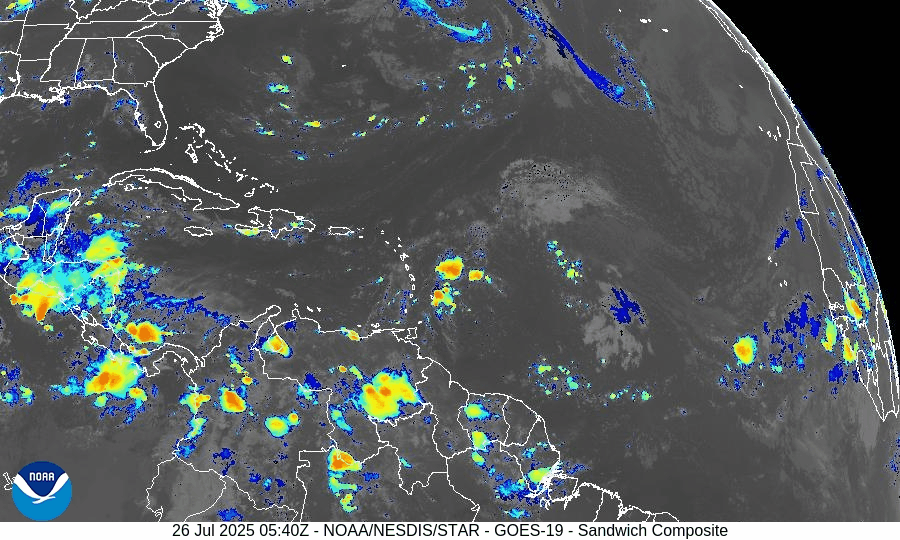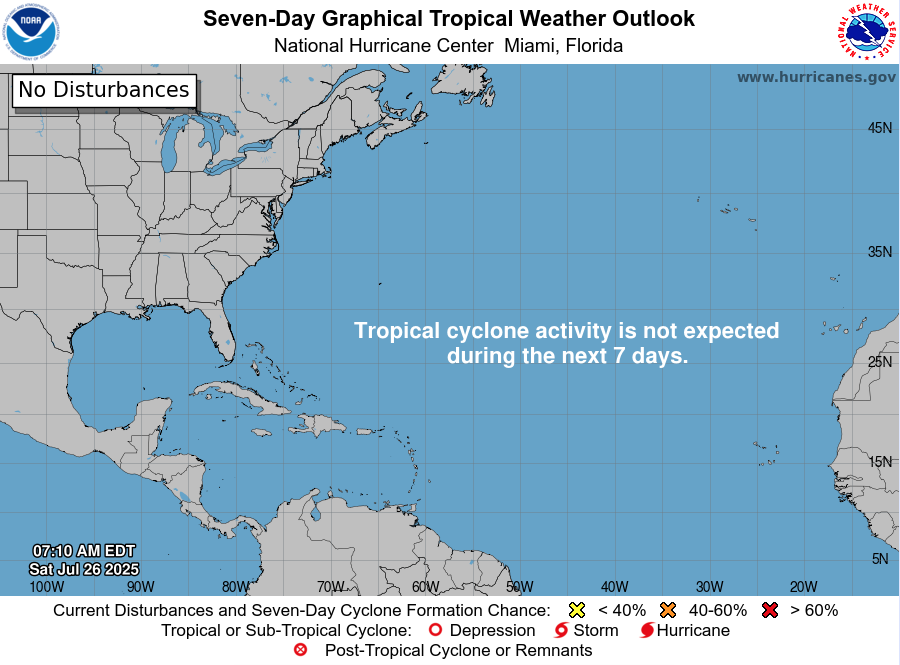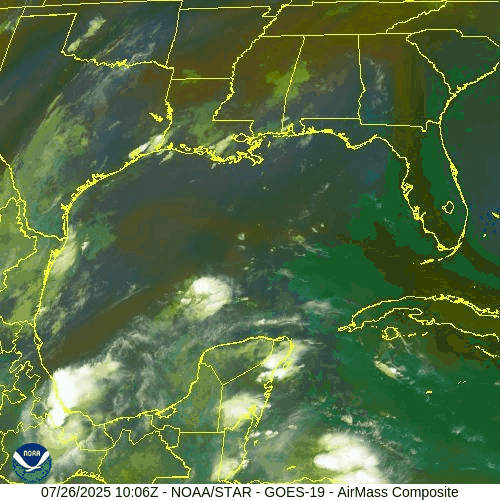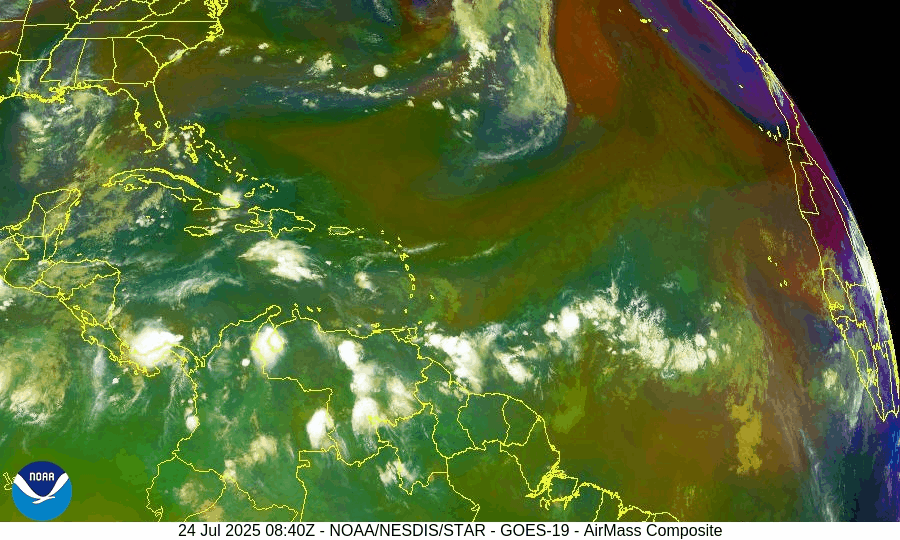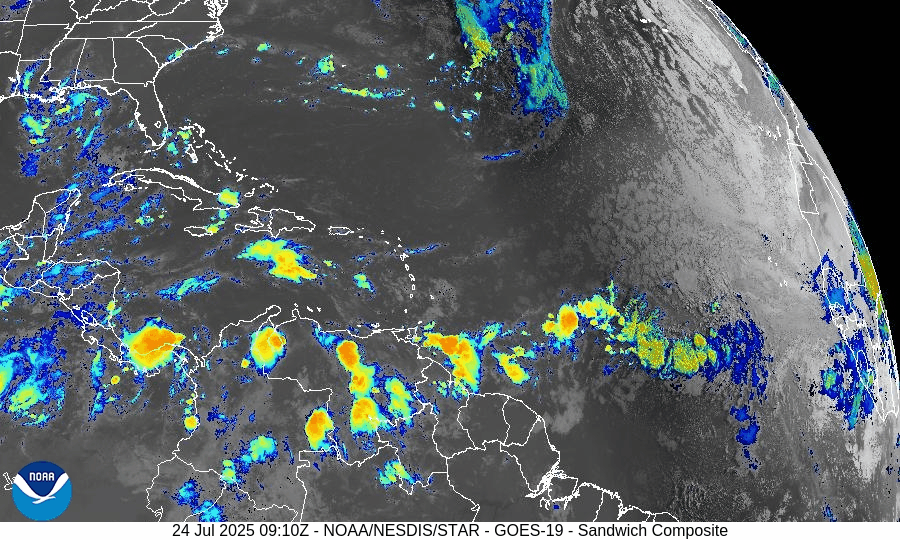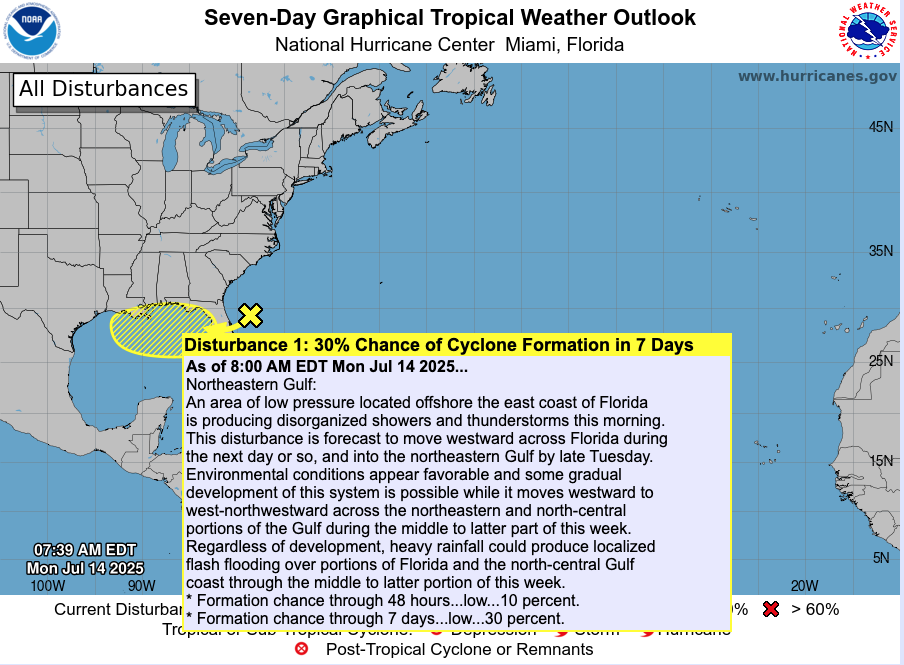Atlantic Hurricane Outlook – July 26, 2025: Gulf Moisture Lingers, Deep Tropics Show Early Signs of Change
Moisture continues to stream into Texas and Louisiana from the Gulf, while tropical waves in the deep Atlantic hint at a pattern shift. No named storms yet, but conditions are slowly becoming more favorable.
The Atlantic basin remains free of any named tropical cyclones, but not without activity. A persistent disturbance in the western Gulf of Mexico continues to funnel tropical moisture into parts of Texas and Louisiana, while multiple tropical waves in the deep Atlantic are stirring early signals of future development.
This mid-season quiet is not unusual—but subtle shifts are beginning to show across the basin. As we approach August, conditions will slowly lean more favorable for storm formation.
Gulf of Mexico: Persistent Moisture, Low Development Potential
NOAA/NESDIS/STAR – GOES-19 Air Mass Composite – July 26, 2025 (Gulf)
A weak surface trough remains in the western Gulf of Mexico, associated with disorganized showers and thunderstorms.
Current Status: No surface circulation, limited upper-level support
Rain Impacts: Coastal Texas and Louisiana remain under intermittent showers and thunderstorms through the weekend
Development Chance: Still near 0%—but the system is being monitored for changes
Elsewhere in the Gulf, conditions remain stable, with light to moderate winds and seas of 2–5 ft across most zones.
Tropical Waves: Marching Westward, Holding Potential
Several tropical waves remain active in the central and eastern Atlantic:
Wave near 40°W: Moving west at ~10–15 kt, producing scattered convection. Still disorganized but in warm waters with marginal wind shear.
Wave near 23°W (off Africa): Embedded in the monsoon trough. Convection flaring along southern flank; too early for development but bears watching.
None of these waves currently show signs of imminent organization, but they are tracking into warmer waters and a slowly improving environment.
NOAA/NESDIS/STAR – GOES-19 Sandwich Composite – July 26, 2025 (Tropical Atlantic)
Sea Surface Temperatures: Primed for August
Gulf of Mexico: 86–88°F across most areas
Caribbean Sea: Upper 80s°F, especially in the western basin
Main Development Region (MDR): 82–84°F, 1–2°F above average
The Atlantic remains historically warm, a key ingredient for fueling tropical cyclones as we near peak season.
SST data courtesy of Windy.com
Atmospheric Conditions: Gradual Shift Unfolding
Wind Shear: Still moderate in the central Atlantic, but weakening trends are forecast
Moisture: Mid-level moisture increasing, especially south of 20°N
Saharan Air Layer (SAL): Still active, but thinning between 35°W–50°W
These slow, quiet changes signal a transition to a more favorable setup in early August.
Dust & SAL data from Windy.com
Florida Forecast
Today’s Weather:
High: 90°F
Conditions: Partly sunny, humid
Storm Risk: Scattered inland thunderstorms after 2 PM
Winds: Light and variable
Prep Reminder: Monitor drainage around your property during afternoon storms
Rain forecast data courtesy of Windy.com
Prep Tip of the Day: Check Local Shelters & Pet Plans
Locate your nearest hurricane shelter—especially if you're new to your area
Identify which shelters allow pets (many do, but require pre-registration)
Add leash, crate, and vaccination documents to your go-kit
Looking Ahead: Window of Quiet Before August Heats Up
Although no named systems are expected in the next 5–7 days, the setup across the basin is gradually shifting. The Gulf disturbance remains weak, but new tropical waves are aligning with less hostile conditions.
This is the time to finalize your hurricane supplies, prep your property, and stay informed.
Check back tomorrow for another update from Cat5Prep.com.
Atlantic Hurricane Outlook – July 24, 2025: Gulf Disturbance Monitored as Tropics Remain Broadly Quiet
A weak disturbance in the Gulf of Mexico brings rain to the Gulf Coast, but tropical development chances remain low. Meanwhile, the broader Atlantic remains quiet.
As we near the close of July, the Atlantic remains largely stable, but the National Hurricane Center is monitoring a weak disturbance in the Gulf of Mexico for any signs of development. While conditions remain broadly unfavorable for rapid formation, subtle shifts in the atmosphere suggest we’re approaching a more active phase of the season.
Atlantic Basin: Broad Stability, But Eyes on the Gulf
As of the 8:00 AM EDT Tropical Weather Outlook, the National Hurricane Center (NHC) is reporting:
No active tropical cyclones
One disturbance in the Gulf of Mexico with low development chances
No tropical cyclone formation expected elsewhere over the next 7 days
NOAA/NESDIS/STAR – GOES-19 Air Mass Composite – July 24, 2025
Gulf of Mexico: Surface Trough Brings Rain, Low Development Risk
A broad surface trough located over the north-central Gulf of Mexico is generating scattered showers and thunderstorms. While upper-level winds remain hostile to development, the NHC notes this system could persist for several days as it drifts slowly westward.
Formation chance (7 days): Low (near 10%)
Main impacts: Localized heavy rain along portions of the Gulf Coast (especially Louisiana, Mississippi, and Alabama)
Conditions: Disorganized thunderstorm activity, no defined surface circulation
Expect periodic showers and thunderstorms over coastal waters and possible heavy rainfall inland through the weekend.
Rainfall forecast (ECMWF) courtesy of Windy.com
Caribbean Sea: Breezy Trades, Typical Mid-Summer Weather
No disturbances of concern
Fresh easterly trade winds dominate the central and southern basin
Scattered convection near the coasts of Central America (Panama, Nicaragua) due to the East Pacific Monsoon Trough
Seas remain moderate, with wave heights of 4 to 7 feet in open waters.
Wind forecast (ECMWF) courtesy of Windy.com
Wave height forecast (ECMWF Waves) courtesy of Windy.com
Atlantic Tropical Waves: Multiple Waves Marching West
GOES-19 - Sector view: Tropical Atlantic - Sandwich - July 24, 2025
Several tropical waves are present across the Atlantic:
Central Atlantic Wave (~35W): Slowly advancing west with scattered convection, no signs of organization yet.
New Wave Near 23W (Far East Atlantic): Recently introduced by the NHC; embedded within the monsoon trough, showing convective activity near its southern flank.
Low Near 08N44W: Part of the broader monsoon trough; helping to enhance scattered thunderstorms but remains disorganized.
These features will be monitored over the next 7–10 days as they move into warmer waters and potentially more favorable conditions.
850 hPa wind data courtesy of Windy.com
Saharan Air Layer (SAL): Dry Air Suppressing Growth
The Saharan dust plume continues to stretch across the central Atlantic, limiting tropical development by reducing moisture and increasing wind shear. However, long-range forecasts suggest the SAL may begin to thin as we move into August, potentially opening the door for more development.
Saharan Air Layer (SAL) dust data courtesy of Windy.com
Sea Surface Temperatures: Hot and Getting Hotter
Ocean temps across the basin remain above average:
Gulf of Mexico: 30–31°C (86–88°F)
Caribbean Sea: 29–30°C (84–86°F)
Main Development Region (MDR): 28–29°C (82–84°F)
These conditions are supportive of development—but only if wind shear and dry air ease.
Sea surface temperature data courtesy of Windy.com
Florida Forecast
Highs: 89–91°F
Rain Chance: 50–60%, mainly afternoon thunderstorms driven by seabreeze interaction
Winds: Light southeast winds
Hazards: Isolated downpours, brief gusty winds
Rain forecast data courtesy of Windy.com
Prep Tip of the Day: Review Your Local Evacuation Zone
During quiet days, take time to review your local evacuation maps and zones:
Know when you would leave and where you’d go.
Print hard copies in case cell service fails.
Share your plan with family and neighbors.
Find evacuation information from your county emergency management office or state disaster preparedness website.
Looking Ahead: A Turn Toward Activity?
While the current atmosphere is keeping storms at bay, sea temperatures and tropical wave activity suggest a transition toward increased potential in early August. The Gulf disturbance is not expected to develop significantly, but it reminds us that the quiet can shift quickly.
Stay informed and prepared—Cat5Prep.com will continue tracking it all, daily.
Atlantic Hurricane Outlook – July 14, 2025: Gulf Disturbance Signals Season’s Shift
A weak trough near Florida could organize as it moves into the Gulf of Mexico this week. While not yet a named system, heavy rain and flooding may impact Florida and Gulf Coast states. Stay informed and prepared.
The Atlantic basin remains mostly calm, but the tropics are waking up. A trough of low pressure is moving off the Southeast U.S. coast and entering the Gulf of Mexico, where it's now being monitored for potential tropical development later this week.
Atlantic Basin: Early Signs of Activity
No named tropical cyclones currently.
The trough is producing disorganized clouds and showers along the Southeast coast and across Florida.
According to the NHC, this system has about a 30% chance of organizing into a tropical depression or storm over the next seven days, with a 10% chance in 48 hours.
If it develops, it could move west across the Gulf toward Louisiana and Texas by late week.
Satellite view via Windy.com
Foundation: Ocean & Atmosphere Basics
Sea Surface Temperatures (SSTs) are 2–4°F above average in the Gulf, Caribbean, and Main Development Region—providing the warm fuel needed for development.
Sea Surface Temperature via Windy.com
Wind Shear Courtesy of https://tropic.ssec.wisc.edu/
Wind shear remains moderate-to-strong across much of the basin; however, conditions in the northeastern Gulf may become more favorable for storm organization.
Saharan dust continues to suppress development in the eastern Atlantic, but this trough is well west of that region.
Saharan Air Layer (Dust) via Windy.com
Local Weather: Rain and Thunderstorms Ahead
Florida: Expect multiple rounds of heavy rain and thunderstorms today through Wednesday as the trough crosses the peninsula.
Gulf Coast (AL, MS, LA, TX): Showers, thunderstorms, and flooding potential increase by mid-to-late week.
Attention zones: Tampa, Orlando, Dolphins could see over 6″ of rain; Houston and Mobile might experience heavy downpours and gusts.
Thunderstorm Forecast (ECMWF) via Windy.com
Prep Tip: Heavy Rain Trumps Wind Now
With flooding as the primary threat:
Ensure your home’s drainage systems are clear.
Prepare sandbags and supplies if you live in low-lying or flood-prone zones.
Keep flashlight, battery-powered radio, and emergency kits on hand.
Continue monitoring NOAA Weather Radio and local alerts as storms advance.
Looking Ahead: Watch This Week Carefully
As the trough moves into the Gulf, developing into a tropical depression or storm is possible.
Even without full tropical development, heavy rain and localized flooding pose a risk to the Southeast U.S. and Gulf states.
This activity could become the season’s first system to affect U.S. mainland—track it closely over the next 3–7 days.
Stay tuned to Cat5Prep.com for your next daily update—this season may be shifting right before our eyes.
Atlantic Hurricane Outlook – June 4, 2025: A Flicker on the Horizon
Though no storms are active, key hurricane ingredients are aligning fast. A developing low near the Southeast U.S. and rising SSTs suggest change is coming.
The fourth day of the 2025 Atlantic hurricane season opens with quiet skies—but a subtle shift is underway. For the first time this season, the National Hurricane Center (NHC) has flagged a potential area of interest offshore the southeastern United States. While development chances remain low, it’s a reminder that conditions are evolving and the atmosphere is beginning to stir.
Atlantic Basin: A New Watch Zone Emerges
As of this morning’s Tropical Weather Outlook from the NHC:
No active tropical cyclones
One area of interest off the Southeastern U.S. coast
No tropical development expected in the next 48 hours
Low (10%) chance of development over the next 7 days
A non-tropical low pressure area is forecast to form near or offshore the Southeast U.S. coast.
If it remains offshore, it may gradually acquire subtropical or tropical characteristics while drifting northeastward at 10–15 mph.
— NHC Forecaster Reinhart, June 4, 2025
No storm is expected soon—but it’s the first official mention of potential development this season.
Satellite imagery courtesy of Windy.com
Sea Surface Temperatures: Ready for Action
Warm waters across the Atlantic basin continue to deepen—creating an ideal foundation for future storm formation:
Gulf of Mexico: Running 2–4°F above average, with pockets exceeding 86°F (30°C)
Western Caribbean: SSTs remain high, particularly around Central America and Cuba
Main Development Region (MDR): Trending warmer than normal with gradual warming expected into late June
This warm ocean water is the primary energy source for hurricanes—and it’s already in place.
Sea surface temperature data courtesy of Windy.com
Wind Shear & Moisture: Storm Barriers Continue to Erode
Atmospheric conditions are shifting in a storm-friendly direction:
Wind shear is weakening in key zones like the Gulf and Caribbean
Moisture levels are rising at both low and mid-levels of the atmosphere
Vertical instability is increasing, supporting larger, longer-lasting thunderstorms
This transition increases the likelihood that disorganized storms could become organized systems.
Wind Shear Courtesy of https://tropic.ssec.wisc.edu/
Saharan Air Layer: Still a Barrier, But Fading
A broad plume of Saharan dust remains in the central and eastern Atlantic, offering temporary protection:
Suppresses convection
Inhibits thunderstorm growth
Raises wind shear and dry air intrusion
However, models show this SAL influence weakening by mid-to-late June, removing one of the final natural inhibitors.
Saharan Air Layer data courtesy of Windy.com
Thunderstorm Activity: Early Clues
Even in the absence of tropical storms, convective activity gives us clues about what's forming:
Western Caribbean & Bay of Campeche: Disorganized clusters of thunderstorms show signs of persistent convection
Southeastern U.S. Coast: Isolated convection associated with the developing non-tropical low
While nothing is organizing yet, this pattern often precedes early-season development.
Thunderstorm data courtesy of Windy.com
Florida Forecast: Muggy Mornings, Stormy Afternoons
Expect typical summer conditions today across the state:
North Florida: Highs in the upper 80s, mostly sunny, low humidity
Central Florida: Around 90°F, with isolated thunderstorms after 2 PM
South Florida: Mid-80s, high humidity, with a greater risk of scattered PM storms
Afternoon thunderstorms are normal—but they also signal increasing moisture and instability across the region.
Forecast radar data courtesy of Windy.com
Prep Tip of the Day: Snap and Store
With one system on the radar, now’s a good time to check off a simple but essential task:
📸 Take photos of your home, car, and valuables
☁️ Back up those images to the cloud or email them to yourself
🔒 These photos may be critical for insurance documentation after a storm
Also:
Review your hurricane kit and evacuation plan
Sign up for emergency text alerts from local agencies
Bookmark trusted resources like Cat5Prep.com and hurricanes.gov
Looking Ahead: A Season Starting to Stir
It’s still early in the season, but we’re beginning to see motion on the map:
Warm water and shifting winds are laying the groundwork
The Saharan Air Layer is fading
Thunderstorm activity is creeping into critical regions
Today’s 10% chance of development is low—but it may mark the quiet season’s turning point.
We'll continue tracking changes in the Atlantic and bring you updated guidance each day.
Check back tomorrow for your next hurricane update from Cat5Prep.com.

